There are various questions on the forums, even the most unusual and sometimes even stupid ones. But they demand their answer. For example, the question is, what current is in the outlet: AC or DC? The strangeness of the question lies in the fact that everyone knows that alternating current passes in the supply networks of power lines. And this means that in the outlet it will be variable.
This could be stopped, but let's take a look at how alternating current differs from direct current, and why exactly the first one is used in everyday life and in production.
What is electric current
Everyone knows from the school physics program that current is the directed movement of electrons. In all power plants, the principle of generating electricity is the same. To do this, it is necessary that the shaft of the rotary installation rotates. In fact, this is a bundle of copper, which is located between two magnets. You can rotate the shaft with the help of water, wind, hot air (steam) and so on. That is why power plants are divided into types: hydro, wind, thermal, and so on.
What are magnets for? With their help, the electrons inside the copper begin to move due to the formed magnetic field, forming a directed movement, that is, a current flow. To release electrons, a wire is connected to copper, which diverts current from the installation.
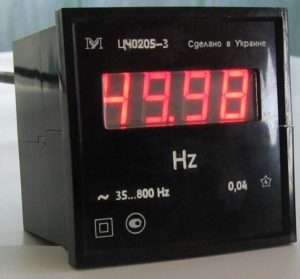
But why is the current generated by the power plant called alternating? It's all about changing the direction of electrons. There are indicators such as the frequency of the current and its voltage. So in domestic electrical networks the current frequency is 50 Hz, and the voltage is 220 volts. The frequency indicates that in one second the current changes its direction 50 times, and, accordingly, the charges of the particles from positive to negative. As for the voltage, in fact, this is the pressure or pressure of the electrons in the network.
So, alternating current is a change of charges. Therefore, the voltage changes from maximum to minimum and vice versa 50 times in one second, for a total of 100 times. Then it becomes the maximum (100%), then the minimum (0%). And this cycle keeps repeating. If the voltage in the network was always constant, and besides, the maximum, then its wiring would require an electric cable of a huge cross section. This is not necessary with variables. A small diameter wire can carry millions of volts.

So, answering the question, what is the current in the outlet, you need to know why it is variable and not constant. And yet why D.C. so called. First, it never changes its direction, does not jump and has no frequency. Secondly, it is present only in batteries and accumulators, as well as in generator sets.
Sockets
So, we move further on the topic of what current is used in the outlet: direct or alternating. Let's move on to sockets, because they meet in the question. So, are there sockets for DC voltage, and for AC? Let's just say there is. How do they differ from each other?
Let's start with the fact that the sockets in which there is AC voltage, are denoted by the symbol (~) or the letters of the Latin alphabet (AC), that is, Alternating Current, which with of English language so it translates - alternating current.
DC outlets are identified by the symbol (-) or the letters DC (Direct Current). In the diagrams, such sockets are indicated by plus and minus with an arrow. Immediately make a reservation that in the outlet, where there is constant pressure turning on ordinary household appliances is useless. Still won't work. Pay attention to the figure below, where the icons are indicated.
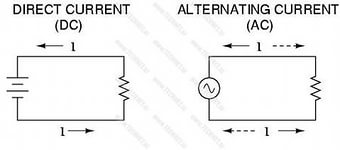
So, many manufacturers put them on sockets for ease of recognition, that is, for what voltage they are intended. As you can see, even purely visually, you can determine what voltage is in the outlet: constant or variable. Of course, all these are nuances, because domestic networks supply only alternating current, so there is no need to even look at what marking the outlet has, whether there are special characters or not.
Summing up
Electricity is the energy that is used everywhere. This is the main source of human life, without which today it is impossible to survive. This is especially true for cities and large towns. People are used to the fact that electricity is present in their lives, as an integral part of being. Therefore, short-term shutdowns are perceived by many as a disaster. Therefore, one recommendation for everyone - save electricity, as life shows, everything does not last forever under the moon.
Modern electrical appliances are designed to be as user-friendly as possible and in order to use them it is absolutely not necessary to know what current is in the outlet where they are connected. Such knowledge may never be useful in Everyday life- it is usually enough to know that there is a current in the outlet, thanks to which all household appliances work.
Where electrical knowledge can come in handy
It’s good if questions about the principles of operation of electrical appliances arise simply from “sporting interest”. It happens worse when traveling to another country, where unprepared travelers are surprised to find sockets of an unfamiliar type. If before that a person paid attention to the inscriptions near “their” sockets, then “strangers” may have a different frequency and voltage. To understand why this is happening, one must at least in general terms learn the basics of electrical engineering.
It is immediately necessary to make a reservation that everything described below is given in a very simplified and exaggerated form. Some analogies may not fully reflect all the processes occurring in electrical wiring and are given solely for their general understanding.
Direct and alternating current

This is one of the most important characteristics electric current. Each electrical appliance is designed for a certain type of it and if not connected correctly, at best, it simply will not work.
Any of these currents is created by an electromagnetic field, which causes free electrons to move in metals or other conductors. But with constant current, they fly in one direction all the time, and alternating current pulls them back and forth. In any case, they move and do work, but the devices for transformation electrical energy in mechanical you have to do different. That is, an electric motor, for example, can be made both from a constant and from alternating current, but the first cannot be included in the second chain.
If most electrical appliances are powered by direct current, then to transfer electricity to long distances it is more profitable to use a variable - it is not so sensitive to the resistance of conductors. Therefore, there can be no two opinions about what current in household socket: constant or variable - the second option is always used.
This video describes the historical background for the use of alternating current in power grids:
Phase and zero
These concepts refer exclusively to alternating current. It is generally accepted that the phase in the outlet is an analogue of the DC plus, and zero is a minus, so zero “does not beat” if you touch it. In fact, everything is somewhat more complicated - in alternating current, plus and minus constantly change places, therefore, in a closed circuit (with a connected load), current also flows through zero. But the fact is that it really does not beat, even if you take it with your bare hands - during electrical work, they look for where the phase is in the outlet and without fail isolate this wire, and the rest are left bare without much fear.
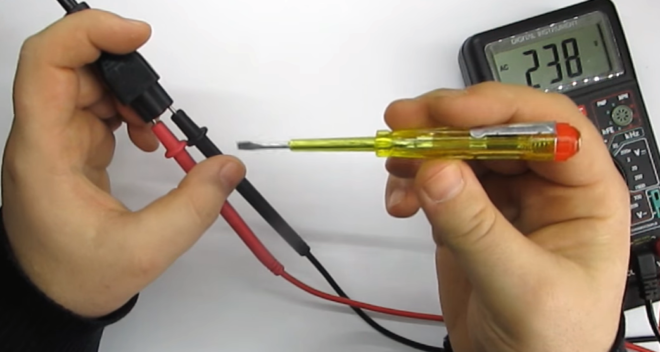
In a properly connected and normally working electrical wiring, zero does not shock a person with current because the so-called consumer connection scheme with a dead-earthed neutral is used. This means that the neutral wire at the substation and at the point of entry into the house are grounded and the current, if it is in the wire, passes "by" the person.
There are a number of conditions under which the neutral wire can be electrocuted. If there is no relevant experience in handling electrical wiring, you should not count on the fact that zero is always safe.
grounding
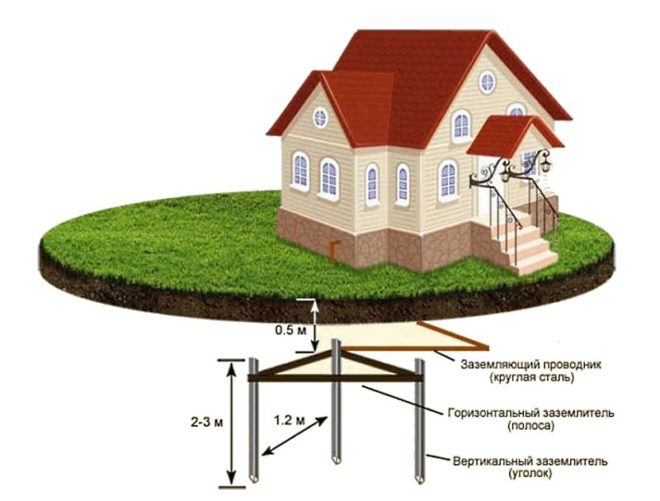
A socket without a ground wire is not uncommon for old houses, because powerful electrical appliances were practically not used in everyday life. Modern safety requirements for electrical appliances are much stricter, so sockets installed without grounding simply cannot be used even in a project.
The meaning of grounding in additional protection. If you use a socket without protective earth, then in most cases the instrument case is connected to the working zero. As a result, if the phase enters the body of the device (during the breakdown of the insulation), then a short circuit occurs and knocks out the protective plugs. This leads to damage to the device, and is relatively safe for a person, on one condition - if he did not touch the device at the time of the circuit. Otherwise, until the protection works, the person is shocked short circuit, which is ten times higher than the nominal value.
Grounded sockets divide zero into a worker, necessary for the operation of the device, and a protective one. The case is now connected to ground, and zero is operating normally. If a phase gets on the case, then the socket grounding contact “leads” it away from the person, even if he touches the device at that moment, and the protective automation turns off the power. It does not shock a person, there is no short circuit, and the device remains as safe as possible. It remains only to find the place where the insulation was damaged and fix the problem.
A socket without proper grounding will work in the same way as with it, but in the event of an emergency, it will not be able to provide adequate protection to the connected devices and the person.
As a result, the question of what is better to install - sockets working without grounding or still with it does not exist - the PUE clearly require a device of the second type to be installed.
Electric voltage
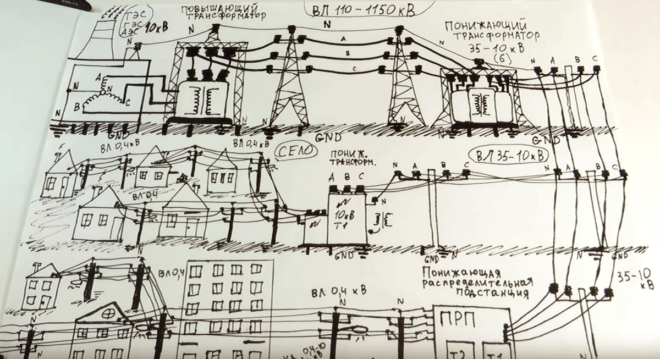
current path from the power plant (click to enlarge)
If you do not use such scientific terms as "tension electric field” and “potential difference”, then the following analogies will help to understand what voltage is in the network and why it is exactly this:
Potential and kinetic energy- the example is very simplified, but the point is that the voltage shows what forces can be involved in moving an electric charge. The main difference is that potential energy is converted into kinetic energy, and the voltage is always stable. You can use this analogy because as long as no device is plugged into the outlet, then there is voltage in it, ready to start moving charged particles, but there is no electric current. The movement of electric current begins only when the load is connected to the wires (or when the zero and phase are closed).
The higher the voltage, the higher its “pushing” ability - this means that at sufficiently large values of it, the current will “break through” the dielectric between the wires. Under normal conditions, the dielectric between the wires is air, so the higher the voltage, the higher the likelihood of lightning (short circuit) between them. This property is used in piezo lighters and ignition mechanisms for industrial furnaces, only in the first case, the distance between the contacts is 0.5 mm and the voltage is several volts, and in the second case, between the contacts is 10-15 centimeters, and the voltage is about 10 thousand volts.
It depends on the voltage how convenient it is to transmit current over long distances - the larger it is, the less losses.
For power lines between cities, a voltage of 150-600 thousand volts is used, in the suburbs it is 4-30 thousand volts, and for consumers, the voltage in the outlet is already 100-380 volts. AT different countries there are their own standards, so before the trip it is worth clarifying this point.
Electric current frequency
One of the parameters of an alternating current, showing how many times per second it will change direction from plus to minus. The full cycle of changes - from zero to plus, then to minus and back to zero is called Hertz. Two frequency standards are used worldwide - 50 and 60 Hertz.
From frequency, as well as from voltage, the losses of current during its transmission depend - the higher the frequency, the less losses. Therefore, the first option is used at a mains voltage of about 220 volts, and the second - at 110.
The frequency of the current depends on the speed at which the generators at the stations generating electricity are spinning. It always remains unchanged - unlike voltage, an error of 0.5-1 Hertz is allowed.
Current strength

socket for 16a (click to see the inscription on the cover)
On the socket cover you can see the inscription 6, 10 or 16A. This does not mean that the current strength in the outlet will reach such values - these are its maximum values \u200b\u200bfor which the socket contacts are designed. Accordingly, in order to find out what current strength, or rather, how many amperes are in the outlet at the moment, you should set it to electrical circuit measuring device - ammeter.
For example, if an electric kettle consumes 2000 watts, then you need to divide 2000 by 220. It turns out about 9 amperes - a current strength that is 18 times greater than what is needed to kill a person.
It is more difficult to calculate the amperage, for example, of a computer. Firstly, during its operation, several devices are connected to the network at once. Secondly, energy-saving technologies use processor resources to a minimum, overclocking it only when solving complex tasks. Therefore, the current strength will change periodically.
These are all the main characteristics of the electric current, which are enough to know to get at least a general idea about it. When traveling to another country where other regulations may apply, it will be enough to find out what voltage and frequency are in the network. If they differ from those for which the phone is charged (or other devices that can be taken on a trip), then you will additionally have to decide what to do in this situation.
Alternating and direct current in relation to sockets
As a rule, according to the standard, alternating current is used in the sockets of ordinary residential buildings and apartments. Because of this standardization, few would ever wonder what type of current is being used in a socket? However, it should be immediately noted that not all types of sockets work with alternating current.
Varieties and characteristics
The main characteristic in the outlet is not the strength and type of current. The dominant position among the characteristics is occupied by:
Contacts (shape and type of plug);
- protection power.
Here we should not forget about the permissible current limits. In principle, it is not difficult to determine what current is in the outlet.
When choosing a new outlet for your home, it is highly recommended to consider the following features:
Place of installation of the socket (including how it will be installed: inside the wall, on the street, on the surface of the wall, etc.);
- the strength of the network and the load on the wiring at the installation site;
- the shape of the plug and socket;
- the degree of protection (from children and other possible external stimuli).
It is not recommended to install external sockets near the floor (low), even if the room is sufficiently dry. This is due to the fact that there is a possibility of direct water entering the device when washing the floor and other similar actions. Due to contact with water, the power of amperes and volts will be broken by shorting the plugs.
Important! Water is a significant enemy of electrical appliances due to its throughput. The socket is no exception. Any contact of liquid with the socket may cause a short circuit.
As a rule, the marking of an outlet of any kind prescribes the recommended installation locations and the possibility of short circuits when in contact with liquid (especially water).
In order to make it easier to deal with the markings of a particular outlet, there is a diagram shown in the figure.
The degree of protection of a device of any kind is indicated by special numbers - the IP code. This code consists of two parts:
The first part can include any number from 0 to 6 and means the degree of external protection (from fingers, dust, etc.);
- the second part of the code contains a number from 0 to 8 and indicates the degree of protection of the device from water.
This IP code can be found on the device itself. It is worth paying attention to the following literal examples of the marking number:
IP00 - a device with this designation does not guarantee any protection at all, that is, in fact, it has "bare" contacts;
- IP68 - a socket with this number, based on the above specification, is protected from absolutely any exposure to liquids and guarantees a minimum possibility of short circuit.
In addition to all of the above, each type of sockets and plugs is marked in the form of Latin letters. Table of the main marking according to appearance can be seen in the image below.

In most cases, in Russia, without taking into account the ampere strength, sockets are used under the marking letter C (without grounding) and F (with grounding). Some electrical devices have a plug of a type that does not match most Russian sockets, type C and F. You can correct the misunderstanding of an incompatible contact using specialized adapters (without losing amperes).
Paying attention to the differences between Russian and European sockets, it is worth paying special attention to the diameters of the plug contact. Thus, for Soviet devices, the contact has such a large diameter that it simply cannot fit into a socket originally designed for European standards.
The diameter of Russian plugs is 4.8 mm, while the size of the Euro socket socket is limited to a diameter of 4 mm. As a rule, all types of sockets have a standard similar to this.
Symbolism
As a rule, the standardized letter abbreviation AC / DC is responsible for the designation of the type of energy. Literally, AC/DC stands for direct alternating current.
The acronym for direct current (DC) is much rarer than any other. Having stumbled upon an outlet with this designation, you should immediately take into account that it is strongly not recommended to connect ordinary electrical appliances to this point. This device was originally designed to power appliances that require a constant flow of amperes. It should also be noted: DC sockets have a separation of contacts into "-" and "+".
In the case of alternating current (AC), the contacts do not have a separation into "+" and "-". The main feature of this type of electricity is that it does not have a specific direction. For a visual representation of the principle of operation of AC / DC, you can consider the picture below.

In addition to the AC / DC symbols on the outlet, according to the standards, there is a marking in hertz, which carries information about the frequency of changing the direction of the volt flow. Alternating and direct current, as a rule, has a standard equal to 50 Hz. How many hertz in a particular outlet can be easily found out just by looking at the device.
Characteristics
It should be noted right away that not all manufacturers show a sufficient level of care for consumers, which is why their devices are labeled. That is, it is impossible to find out how long the current changes and what kind of energy is in such sockets. In some sockets, on the contrary, there is even a reduced circuit shown in the image above.
In addition to the previously described markings, the device has a “permanent connection” designation. That is, the value allows you to determine whether it is possible to remove the plug from the socket without a certain "secret". This can be regarded as the main protection against children. A removable socket usually has the ability to be removed if necessary.
In addition to the devices described above, there is a removable socket with an extension cord. This is a relatively new device on the market, which is why for many people it is something unknown. The peculiarity of this outlet is the ability to use it as an extension cord.
Important! The plug-in socket is only partly covered by the specifications.
How many volts should it be?
The source of electricity also has certain power requirements. The following situation can be cited as an example: with 4 kilowatts on one network line, you can safely connect standard household appliances, such as a microwave, kettle and iron.
In summary, it is worth noting only that all the above requirements for determining direct and alternating current in the outlet should be taken into account.





